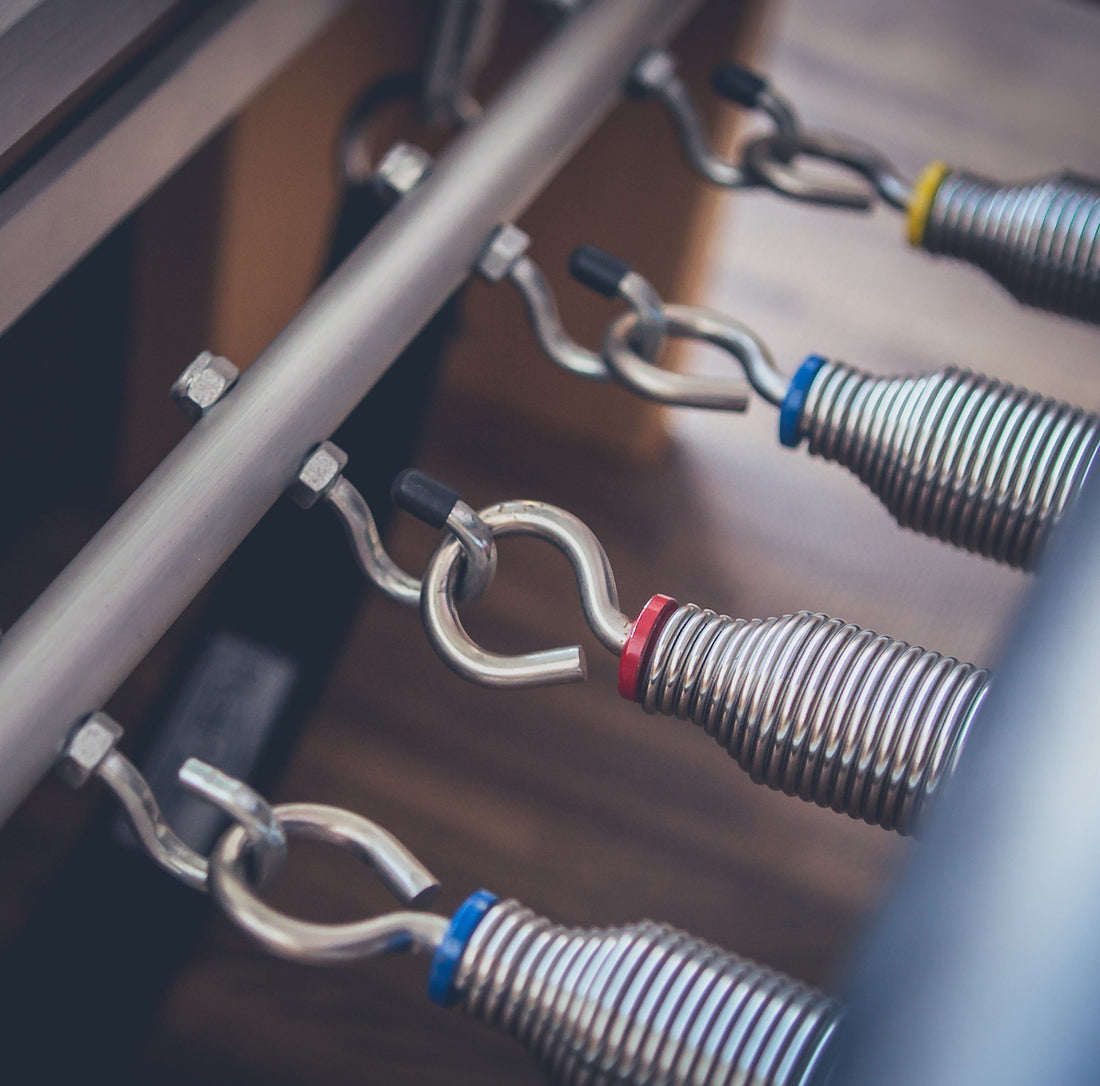After upgrading to a Pilates reformer machine, one of the biggest differences you’ll notice is the sweat and muscle burn you’ll feel after just one workout.
Thanks to their sophisticated construction, the Pilates reformer allows users to optimize their movements with the perfect resistance level to stay balanced and engage deeper muscles using the Pilates reformer springs.
Unfortunately, one of the most confusing aspects of the Pilates reformer that customers tell us about is figuring out how to adjust their Pilates reformer spring settings. While many tend to think that heavier springs make for the hardest workouts, it’s often the opposite.
So to help you gain the most out of your workouts with Pilates springs and achieve the right Pilates reformer spring settings, we’ve created this guide on everything you need to know about Pilates springs.
What Are Pilates Reformer Springs?
Pilates springs are coils found on a Pilates reformer that provide tension during exercises. The main goal of Pilates springs is to provide weight resistance or stability during workouts so that users can increase their muscle burn or achieve better balance.
Pilates springs add tension to exercises that tend to increase with carriage movement. For this reason, lighter springs are often harder to work with because users must rely on their body weight and muscles to maintain proper balance during carriage movement. If you’ve ever done a plank of a Pilates reformer, you’ll know what we mean.
On the other hand, Pilates springs can provide added weight resistance (up to 200lbs. depending on the machine) that helps build muscle during workouts.
So if you’re doing the footwork, you’ll notice added resistance in your legs as you stretch your legs outward, similar to the resistance you’d get on a leg press machine.
However, the primary difference between Pilates springs and weight machines is that springs provide varying tension throughout the exercise. Since springs build tension as they stretch, you’ll notice more resistance the longer you stretch the springs. For example, if you’re performing footwork, you’ll feel very little tension as you initially move or return to the starting position.
Most standard reformers feature a set of four to six springs attached to the carriage that provides tension as the carriage moves. However, a Pilates Cadillac may come with over a dozen tension springs attached to various straps and balancing bars on the trapeze tower.
Understanding Pilates Reformer Spring Settings
Managing your Pilates reformer spring settings is truly a balancing act because these springs are meant to provide you with stability. For this reason, Pilates springs are as much of a safety feature as they are an added amenity.
Whether you have a traditional or contemporary Pilates reformer, the spring settings may be slightly different. For example, most traditional reformers come with four springs, labeled as follows:
- 1 Heavy (typically red)
- 2 Medium (typically Yellow)
- 1 Light (typically Blue)
However, every brand and device has its own set of different spring settings and resistances. For example, most Peak Pilates devices use a combination of four to five red, yellow, and blue color-coded springs, while Balanced Body devices also incorporate a separate green heavy spring for many of their reformers.
Depending on your device, your spring settings may be determined by which color-coded one you add or the aggregate resistance of the number of springs you add.
For example, a workout on a traditional four-spring carriage may call for only two springs, which may mean one full and one half-length spring.
Setting your Pilates reformer spring settings will depend on the following factors:
- The exercise: The amount of resistance should vary on each exercise, and whether heavier or lighter springs make it more challenging.
- Your bodyweight: Bodyweight will determine how much resistance you need to keep your body balanced.
- Your strength/experience: Your experience and proficiency will determine how advanced you can set springs to make workouts more difficult.
- The device: Each reformer will have different spring settings and weight resistances, determining how much resistance you need for each exercise.
5 Tips for Working with Pilates Springs
1. Find the Right Pilates Reformer Spring Settings
Experiment with different spring settings throughout your favorite exercises to determine your strength, comfort, and proficiency level. Since springs tend to differ between each device, there may be some trial and error before you find a spring resistance you are comfortable using.
2. Focus on Balance First
While many mistakenly believe that Pilates springs are about weight resistance, they are primarily a safety feature meant to hold your balance. Since many exercises, from side splits to planks, require you to balance on a moving platform, having too light of a spring setting could disrupt your movements and put you at risk for an injury.
For this reason, we recommend tinkering with your Pilates reformer spring settings to a resistance level that allows you to be in full control of your movements.
3. Take Slow Movements
At the end of the day, Pilates is not about explosive muscle growth or fast twitch muscle workouts; Pilates is about slow, coordinated movements that promote balance, flexibility, and strength.
Keep movements slow, ensuring you’re in complete control and fully stable through workouts. The last thing you want is risking injury or missing out on benefits because you’re trying to hack your way through your workouts.
4. Take Deep Breaths Through Exercises
Similarly, you want to keep movements slow and purposeful, prioritizing deep breathing techniques that promote wellness. This tip will also ensure you don’t engage in any rapid or jerky movements that disrupt your workout and that you work deep muscles evenly.
5. Be Sure to Take Breaks Between Exercises
Finally, working out on a reformer is much more exhausting than on a mat. You’ll notice from the very first exercise when you start to break out a sweat and feel that deep muscle burn after one session.
Ensure that you give yourself enough time to rest in between exercises to maintain your focus on all the other stuff we listed above.
How Often Should I Replace Pilates Springs?
If you’ve owned Pilates equipment before, you’ve probably noticed that springs tend to be heavier when you buy them. Unfortunately, many Pilates reformer springs tend to wear and oxidize with use and often require replacement every two years.
Be sure to consult your manual to see what the manufacturer recommends. Every brand has different policies, but many brands, such as Peak Pilates and Balanced Body, often recommend replacing springs every two years, especially after daily use.
Theoretically, Pilates springs should last nearly a lifetime, but they tend to wear and oxidize if stretched past their limit regularly. Unfortunately, if Pilates springs break, they can be incredibly dangerous and cause serious harm.
Thankfully, Pilates springs are often under $100 and less than the cost of replacing a reformer if one snaps and causes damage.
Here are a few signs that your Pilates springs need replacing:
- Visible oxidation of the metal coil
- Waves or uneven exterior surface
- Visible gaps in the coils from being stretched too far
Conclusion
Pilates springs are a valuable part of your reformer that helps you maintain stability through workouts and build better muscle tone. You can continue to get the most out of your reformer device by following these tips and replacing your springs when required.
Browse our selection for the best Pilates reformers on the market. We offer the best brands and free shipping on all products so you can save money and get started with Pilates at home.





